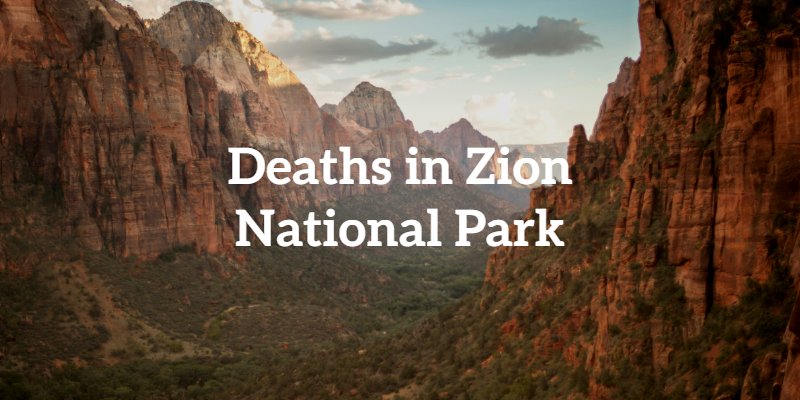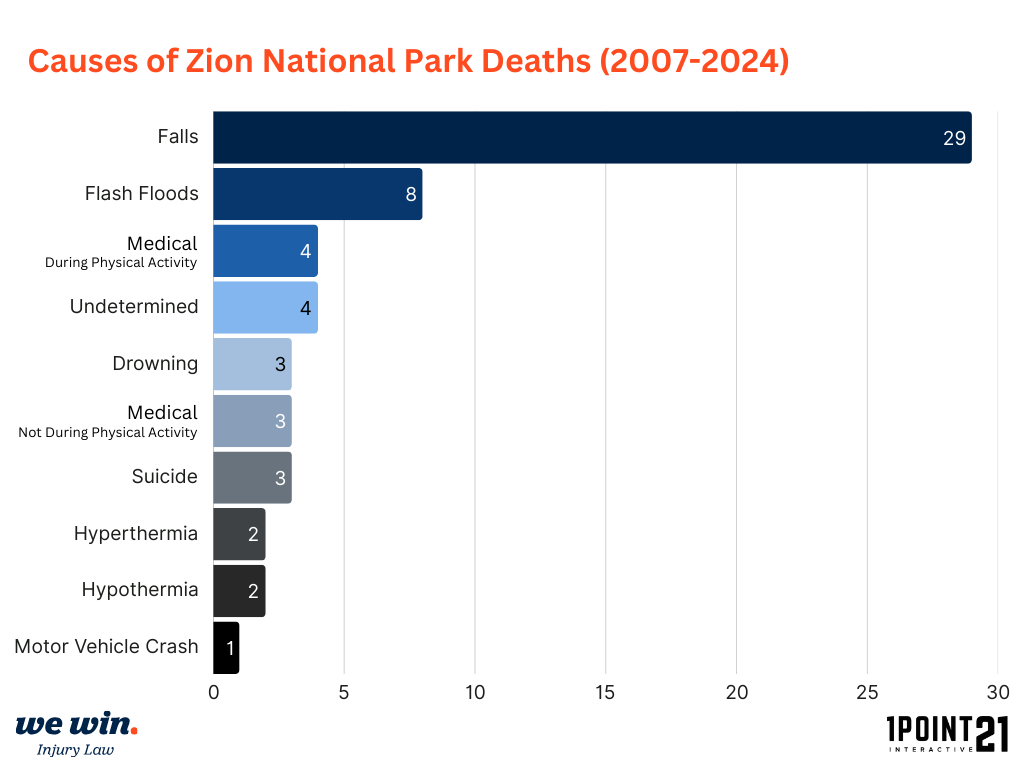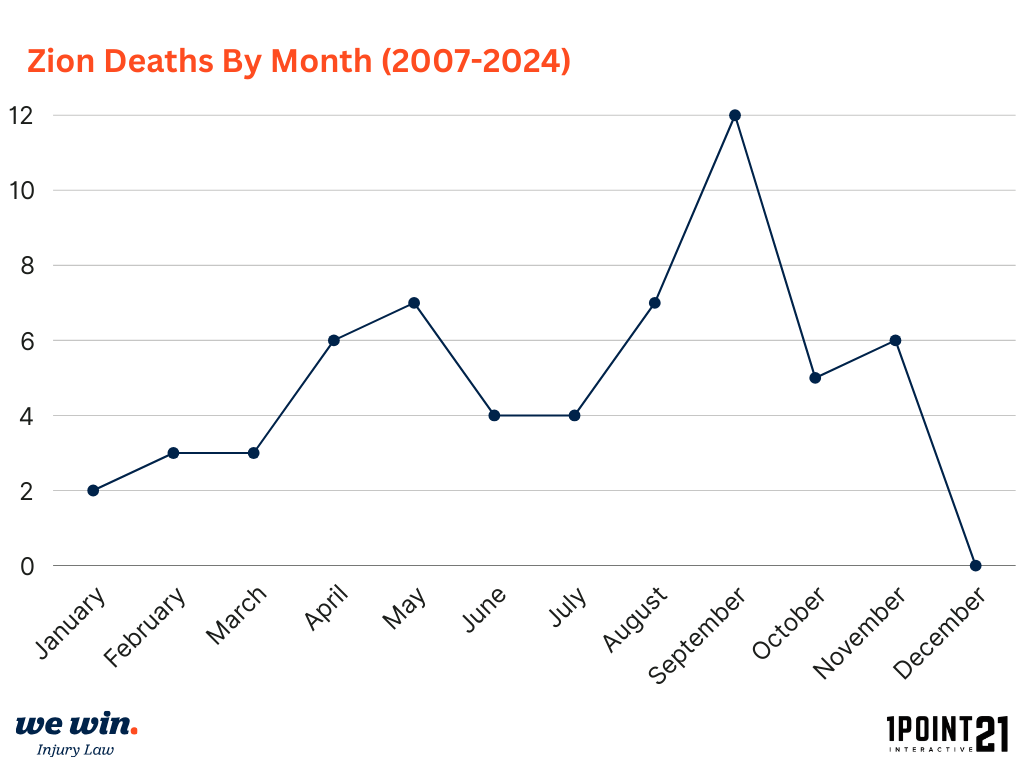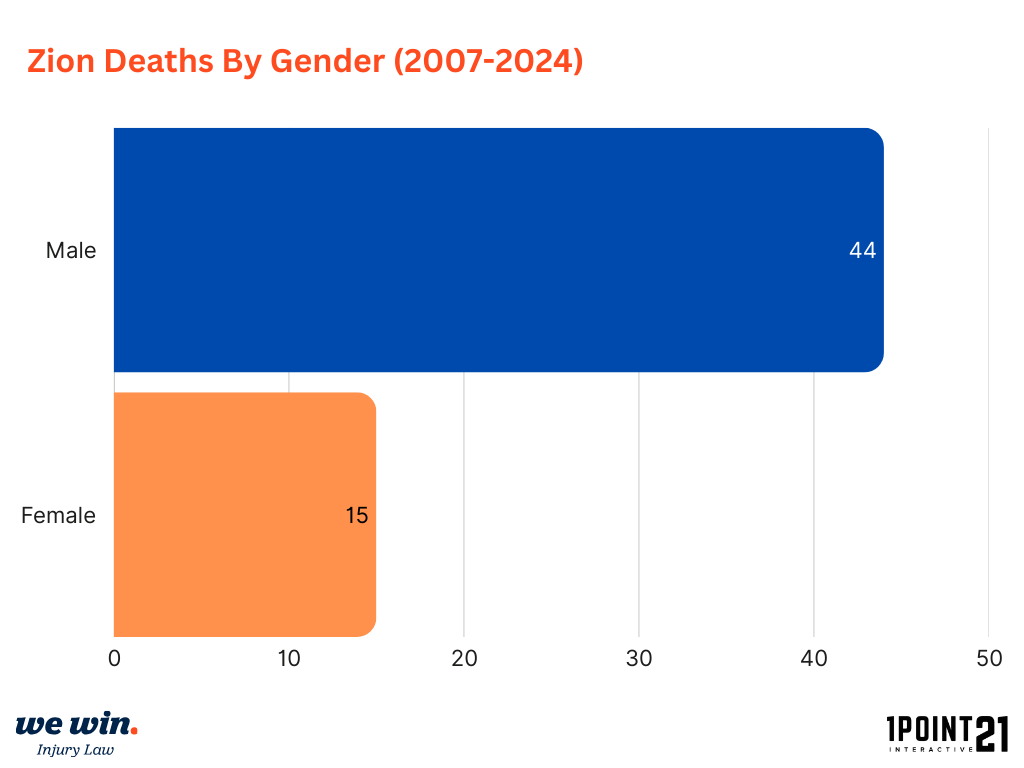Deaths in Zion National Park [2025]
Request Free ConsultationZion National Park, located in southwestern Utah, is one of the most visited national parks in the United States. Known for its towering sandstone cliffs, narrow slot canyons, and breathtaking vistas, the park attracts millions of visitors each year. While its natural beauty is undeniable, Zion also presents significant dangers. Rugged terrain, unpredictable weather, and human misjudgment have contributed to numerous fatalities throughout the park’s history.
This report examines the history of deaths in Zion National Park, exploring common causes, notable incidents, and efforts to improve visitor safety. By understanding the risks associated with the park, both visitors and officials can work toward preventing future tragedies. Whether due to accidental falls, flash floods, heat exhaustion, or medical emergencies, each fatality serves as a reminder of the challenges posed by the wilderness. Through this analysis, we aim to highlight the importance of preparation, caution, and respect for the natural environment.

Jump Links
- History of Zion National Park Deaths
- How Many People Die at Zion Annually?
- Zion National Park Statistics
- Zion Deaths By Month
- Zion Deaths By Gender
- Zion Deaths by Age Range
- Notable Fatalities and Incidents
- Zion National Park Safety Measures
- How Visitors of Zion National Park Can Stay Safe
- Visitor Education and Awareness
- Data Sources and Methodology
History of Zion National Park Deaths
Since its designation as a national park in 1919, Zion has seen a long history of visitor fatalities. Early deaths were often linked to exposure, falls, and horseback accidents, as the park’s rugged terrain posed significant challenges. As infrastructure improved and visitation increased in the mid-to-late 20th century, more fatalities were reported, particularly among hikers, climbers, and river-goers unprepared for Zion’s extreme conditions.
In recent decades, the leading causes of death—falls, flash floods, and heat-related illnesses—have remained consistent, with many incidents occurring on high-risk trails like Angel’s Landing and The Narrows. These tragedies have prompted the National Park Service to implement stricter safety measures, including permit requirements, trail closures, and improved warning systems. However, despite these efforts, fatalities continue each year, underscoring the park’s ongoing challenge of balancing visitor access with safety in a hazardous environment.
How Many People Die at Zion National Park Annually?
Between 2007 and 2024, Zion National Park recorded a total of 59 fatalities, averaging approximately 3.3 deaths per year. In 2024, there were at least four fatalities reported, marking a slight increase from the average with the most recent in that year being a 40-year old man who fell 150 to 200 feet in October.
Recently, on February 3, 2025, a 37-year-old man was found on a popular trail at Zion National Park. The hiker, Cesar Herrera-Ruiz, tragically fell to his death on the Canyon Overlook Trail and is the first fatality in the park this year bringing the total of recorded fatalities to 60 people.
While these numbers may seem concerning, they remain low compared to the park’s millions of annual visitors, meaning the vast majority of people who explore Zion do so without experiencing life-threatening incidents. The park’s fatality rate is relatively low given the challenging terrain, extreme weather conditions, and high-risk activities that draw adventurers to the area.
Zion National Park Death Statistics

The data highlights that the majority of fatalities in Zion National Park result from environmental hazards, with slips and falls being the most significant danger. This suggests that the park’s steep terrain and exposed trails pose a considerable risk, especially for visitors who underestimate the difficulty of certain hikes. Flash floods are another major threat, reinforcing the unpredictable and sometimes deadly nature of the park’s slot canyons.
Heat and cold-related illnesses, along with drowning incidents, indicate that extreme weather conditions and water hazards contribute to fatalities, particularly among those unprepared for Zion’s harsh climate. Medical emergencies, both during and outside of physical activity, suggest that pre-existing health conditions can also play a role in visitor deaths. While accidents make up the majority of fatalities, the presence of suicides and undetermined causes shows that not all deaths are related to recreational activities.
Overall, the data underscores the importance of preparation, situational awareness, and adherence to park safety guidelines to mitigate risks.
| Cause of Death (2007-2024) | Deaths |
|---|---|
| Slips/Falls | 29 |
| Flash Flood | 8 |
| Medical – During Physical Activity | 4 |
| Undetermined | 4 |
| Drowning | 3 |
| Suicide | 3 |
| Medical – Not During Physical Activity | 3 |
| Hyperthermia | 2 |
| Hypothermia | 2 |
| Motor Vehicle Crash | 1 |
| Total Deaths | 59 |
Deadliest Months to Visit Zion National Park
Fatalities in Zion National Park are not evenly distributed throughout the year, with the highest number of deaths occurring in September (12 deaths), followed by May and August (7 deaths each). This trend aligns with peak visitation periods, as late spring and early fall are popular times for hiking and canyoneering due to mild temperatures. However, these months also bring increased risks, such as flash floods from late summer monsoons and unpredictable weather shifts.
Winter months, particularly December (0 deaths) and January (2 deaths), see significantly fewer fatalities, likely due to lower visitation and reduced engagement in high-risk activities. Spring and summer months, including April (6 deaths), June (4 deaths), and July (4 deaths), also show notable fatalities, reflecting both the influx of visitors and the challenges posed by heat, water hazards, and difficult terrain.
The seasonal variation in deaths highlights the importance of understanding weather patterns, trail conditions, and environmental risks when planning a trip to Zion. While accidents can happen at any time, visitors should be especially cautious during peak risk months to help prevent unnecessary tragedies.
Distribution of Gender Fatalities in Zion National Park

The data shows a significant gender disparity in fatalities at Zion National Park, with males accounting for nearly three times as many deaths as females. This pattern is consistent with national trends in outdoor recreation fatalities, where men are more likely to engage in high-risk activities such as rock climbing, canyoneering, and solo hiking. Risk-taking behavior, a tendency to push physical limits, and participation in extreme sports may contribute to the higher number of male fatalities.
While women make up a smaller percentage of deaths, they are not immune to the dangers of Zion’s rugged landscape. Factors such as slips and falls, flash floods, and medical emergencies can affect any visitor, regardless of gender. The data underscores the importance of preparation, situational awareness, and adherence to safety guidelines for all visitors, regardless of experience level or activity type.
Breakdown of Fatalities by Age Range in Zion National Park
| Age Range | Deaths |
|---|---|
| 0-14 | 1 |
| 15-24 | 7 |
| 25-34 | 12 |
| 35-44 | 6 |
| 45-54 | 12 |
| 55-64 | 16 |
| 65+ | 3 |
| Undetermined | 2 |
| Total Deaths | 59 |
The data set on fatalities by age range suggests that adults in their mid-20s to mid-60s are the most at risk. The 55-64 age group has the highest number of recorded deaths, followed closely by the 25-34 and 45-54 age groups. This pattern may reflect a combination of factors, including increased participation in strenuous activities like hiking and climbing, as well as potential health-related incidents among older visitors.
Young adults (15-24) account for a notable share of fatalities in Zion, often during challenging activities like canyoneering, climbing, and hiking. Cases such as a Boy Scout succumbing to hyperthermia, a hiker’s fall from Angels Landing, and a motorcyclist’s crash highlight the varied risks. Factors like difficult terrain, high-risk activities, and unexpected conditions may contribute to these incidents.
Fatalities among children (0-14) are rare, likely because younger visitors are more often under direct supervision. Meanwhile, deaths among seniors (65+) are relatively low, which could be attributed to fewer individuals in this age range engaging in Zion’s more physically demanding activities.
Overall, this highlights that while people of all ages face risks in Zion, the majority of fatalities occur among active adults, emphasizing the importance of preparation, awareness, and physical fitness when exploring the park’s rugged terrain.
Notable Fatalities and Incidents
Keyhole Canyon Flash Flood
Date: September 14, 2015
Seven canyoneers were caught in a sudden flash flood while navigating the narrow Keyhole Canyon. A storm had been forecasted, but the group proceeded with their plans. Heavy rain led to a powerful surge of water that trapped and drowned all seven members of the group. The tragedy remains one of the deadliest events in Zion’s history and reinforced warnings about the unpredictability of flash floods.
Justin Bingham
Date: October 6, 2024
A well-known CEO from a prominent tech company tragically lost his life while attempting to summit the Angels Landing trail. Despite being an experienced hiker, he slipped near the chains section and fell. His death has raised awareness around the dangers of this particularly challenging hike, even for seasoned hikers.
Cesar Herrera-Ruiz
Date: February 2, 2025
As the most recent fatality in Zion National Park, a 28-year-old hiker named Cesar Herrera-Ruiz tragically fell while navigating a challenging section of the West Rim Trail. Despite immediate rescue efforts by Zion’s emergency responders, the hiker was pronounced dead at the scene. This incident highlights the ongoing risks of Zion’s rugged terrain, even during the winter months when conditions can be less predictable.
Park Safety Measures and Response Efforts
In response to the recurring dangers in Zion National Park, the National Park Service (NPS) has implemented various safety measures to protect visitors and reduce fatalities. These efforts include physical precautions, educational initiatives, and emergency response systems.
With millions of visitors each year, Zion’s rangers and rescue teams are frequently called to assist those in distress. Search and rescue (SAR) operations range from locating lost hikers to performing high-angle rescues on sheer cliff faces. Due to the park’s rugged terrain, many rescues require specialized training, helicopter assistance, or extensive coordination with external agencies.
To minimize risks, Zion has established numerous safety measures, including:
- Permit Requirements: Hikers attempting strenuous trails like Angel’s Landing must obtain a permit, ensuring that only those adequately prepared can access high-risk areas.
- Warning Signs and Alerts: The park posts signs at dangerous locations, cautioning visitors about steep drop-offs, flash flood risks, and extreme heat conditions. Digital alerts and weather updates are also available through the park’s website and visitor centers.
- Trail Closures: During hazardous conditions, such as heavy rainfall or extreme heat, certain trails or sections of the park may be temporarily closed to prevent accidents.
How Visitors of Zion National Park Can Stay Safe
Safety in Zion National Park starts with preparation and awareness. Visitors should research trails in advance, check weather conditions, and carry sufficient water, especially in extreme heat. Staying on designated paths, respecting warning signs, and avoiding risky behavior near cliffs or flash flood-prone areas can prevent accidents.
High-risk trails like Angel’s Landing require extra caution, and hikers should never underestimate the park’s rugged terrain. In case of an emergency, having a plan and informing others of your itinerary can be lifesaving. By following park guidelines and using common sense, visitors can enjoy Zion’s beauty while minimizing danger.
Visitor Education and Awareness
Education is a key component of Zion’s safety efforts. Park officials provide information through:
- Ranger-Led Programs: These talks and guided hikes emphasize the importance of preparation and safe hiking practices.
- Online and In-Park Resources: Visitors can access safety guidelines through the park’s website, brochures, and information boards at trailheads.
- Social Media and Alerts: Real-time updates on weather conditions, trail closures, and safety tips are frequently shared to keep visitors informed.
Despite these measures, accidents and fatalities still occur, often due to personal misjudgment or unexpected natural events. Understanding and respecting park regulations is crucial for visitor safety.
Data Sources and Methodology
This report relies on multiple sources to provide accurate information on fatalities in Zion National Park. The primary data comes from the National Park Service (NPS) Mortality Dashboard, which tracks deaths across all national parks. Additionally, historical incident reports were gathered from the NPS History Archive, offering insight into past fatalities. For the most recent deaths in 2024 and 2025, information was supplemented with news articles covering specific incidents. By using these sources, this report aims to present a comprehensive and factual account of mortality trends in Zion National Park. If you would like to learn more about wrongful death and slip and fall accidents, reach out to our St. George personal injury attorneys from We Win Injury Law.
